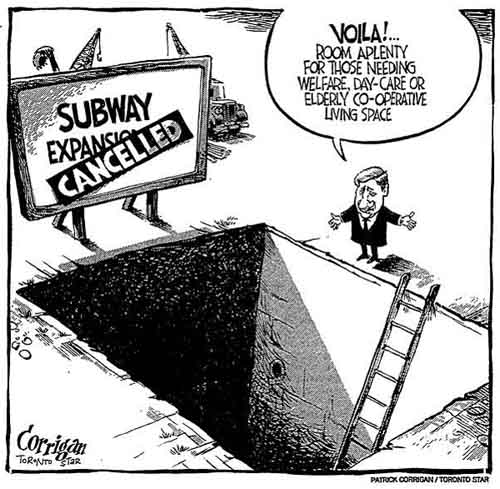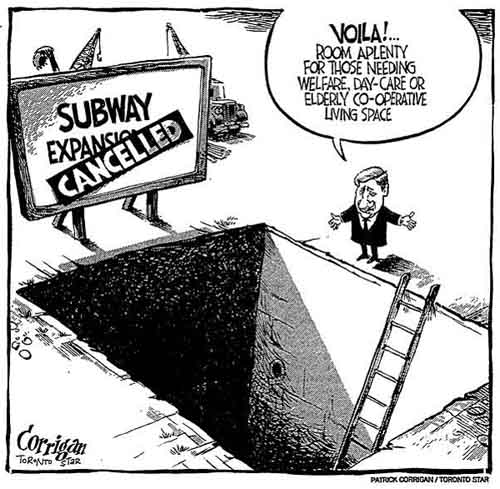sche
Active Member
I think the point was that comparing metro/subway trains to mainline regional railways (i.e. Crossrail and Paris RER) are not fair comparisons. Compared to other subway trains, especially of Toronto-sized cities and metro systems, TTC trains actually are quite large. But frankly, this is not really important.Never said we "must" use massive trains. Just that TTC trains are not outliers, and therefore are a valid option rather than something to be avoided at all costs.
Let's do some back of the napkin math:Placing a hard constrain on one part of operation is not ideal. Possibly it will still work well if there are no other constrains / conflicting requirements, but we will not know that for sure until much later. Meanwhile, the corridor space is gone.
Crossrail and Paris RER run 24-26 tph on two tracks (RER A actually gets to 30tph during peak, but let's use conservative numbers). So let's conservatively say the two local tracks max out at 24tph.
Capacity will be lower if trains have different stopping patterns since the train that stops more will be slower, but this bit of LSE is really short and only has at most one stop on GO express that is not on VIA, East Harbour (even if Gerrard existed, it would probably be local only). With smart scheduling and operations plus fast accelerating trains, the capacity impact can be minimized.
NS runs 6 tph local plus 7 tph express (total 13tph) on two tracks through Amsterdam Lelylaan where the express intercity trains skip two stops.
Since each additional stop makes the speed differential between local and express greater, each additional stop means spacing between trains needs to be greater to allow space for express trains to continue moving without stopping for a local train in front of it.
Based on this let's just say conservatively that 15tph is the limit for the express tracks with both VIA and GO operating where VIA only skips one stop. If VIA trains just slowed down a tad to have the same average speed as the GO trains, 24+ tph would probably also be possible on the express tracks, but let's just use 15tph for now as a no-compromises conservative estimate.
----------------------------------------------------------------------------------------------------------------------
The GO Expansion business case has the following services during peak hours:
- LSE local 4tph (15min headway)
- LSE express 5tph (15min headway), peak direction only
- Stouffville local 8tph (7.5min headway)
- Stouffville express 3tph (20min headway), peak direction only
Let's say VIA does insanely well and runs 2tph to Ottawa/Montreal via the Stouffville Line/HFR and 1tph via Kingston.
It goes without saying that those services are more than doable on four track. Only a fraction of the capacity is used.
How many ppdph is this?
Let's assume we're using single level EMUs, let's use the Crossrail Class 345 trains as an example. They are 200m long and have a max capacity of 1500 people according to their website. If GO continues with 300m platforms, that's 1.5x longer, so each train could hold 2250 passengers at most.
Multiplying by all of the GO services here gets us to 45,000 ppdph in the peak direction, and 27,000 ppdph in the other direction. (excluding VIA)
----------------------------------------------------------------------------------------------------------------------
OK, maybe the service in the GO Expansion Business Case isn't quite good enough. Let's say we do better and use peak GO frequencies proposed in the TRBOT report:
- LSE local 6tph (10min headway)
- LSE express 8tph (7.5min headway)
- Stouffville local 12tph (5min headway)
- no Stouffville express (this makes a lot of sense since the inner Stouffville Line stations are going to be very busy, the Stouffville line is relatively short, and express service on two tracks is less efficient resulting in minimal actual speed improvements)
Say VIA stays at 3tph, with HFR service still using the Stouffville Line.
So the local tracks have 18tph total, which is easily doable. Express tracks are at 11tph total, which is definitely also doable.
Using the same math, this is 58,500 ppdph using the maximum length (300m) single level trains. (excluding VIA)
----------------------------------------------------------------------------------------------------------------------
Now let's make a fantasy scenario to see what kind of peak service would actually be needed to fill those conservative capacity limits:
- LSE local 10tph (6 min headway)
- LSE express 8tph(7.5 min headway)
- Stouffville local 14tph (About 4.5min headway)
- Stouffville express 4tph (15 min headway) -> let's say we made the Stouffville line 3 to 4 track so this is actually possible with significant time savings and the line was extended to Uxbridge so that this actually makes more sense
Let's keep VIA at 3 tph, with trains every 30mins to Ottawa/Montreal via HFR still on the Stouffville Line and every hour to Kingston.
That gets us to our conservative capacity limits of 24tph local and 15tph express.
With 300m single level trains this is... 81,000 ppdph excluding VIA. Absolutely insane.
----------------------------------------------------------------------------------------------------------------------
OK, the last scenario was already getting somewhere completely ridiculous.
But, what if we use non-conservative estimates, allow VIA trains to slow a bit near East Harbour, move HFR VIA service from the Stouffville Line to the Don Branch and CP line (where it makes more sense anyways) and make a scenario that really pushes the limits?
Let's say peak capacity is now 30tph on local and 24tph on express. What's possible?
Example:
- LSE local: 12 tph (5 min headway)
- LSE express: 12tph (5 min headway)
- Stouffville local: 18tph (3 min 20 seconds headway)
- Stouffville express: 10tph (6 min headway) -> this would definitely require a 4 track Stouffville Line, somehow
- VIA to Kingston: 2tph (30min headway)
- VIA HFR to Ottawa/Montreal moved to Don Branch and no longer needs to be considered (though if Stouffville express is removed, there will still be more than enough room)
Calculating ppdph the same as before, we get: 117,000 ppdph on those four tracks excluding VIA, running 300m single level trains. Obviously Union would be completely overwhelmed before the line gets anywhere close to this, and there is no way we would run 300m trains at this sort of frequency, but the potential maximum is insane.
----------------------------------------------------------------------------------------------------------------------
To conclude:
Operations before electronics before concrete is the Swiss railway maxim; if you can get what you need by improving operations, do that, if not, then upgrade signalling/electronics, and only if neither operations nor electronics can solve your problems or get what you want, then you start building tracks and tunnels.
The plans under the GO Expansion Business Case certainly do not require 6 tracks from Gerrard to East Harbour, 4 tracks is far more than sufficient.
If we want almost subway frequency regional rail, similar to the third or fourth scenario above, then we need a bit more stuff - organized and reliable through-run services, modern signalling, fast accelerating EMUs on all services, some grade separations to eliminate conflicts (Scarb Jct, plus one west of Union, plus maybe one for the Richmond Hill line if VIA uses that), and a much more efficient track layout through Union (basically, the TRBOT report). But these things are needed for subway frequency regional rail regardless of whether or not the short section from Gerrard to Cherry is 6 track or not.
So in either case, whether we want GO Expansion Business Case levels of service or almost subway frequency, the OL tunnel is not strictly necessary for providing regional rail.
The only cases where 6 tracks would be necessary would probably be the following:
- If we want close to subway frequencies on GO, and VIA uses like 10tph or something, and Stouffville express trains exist at decent frequency
- If we want sub 5 minute service on LSE and Stouffville, express and local. Given how large the potential capacity is as outlined in the third and fourth scenarios above, I find this pretty unlikely, and besides, Union and USRC would probably be the bottleneck here, not four tracks between Gerrard and East Harbour, which would probably mean building a tunnel for GO/VIA.



